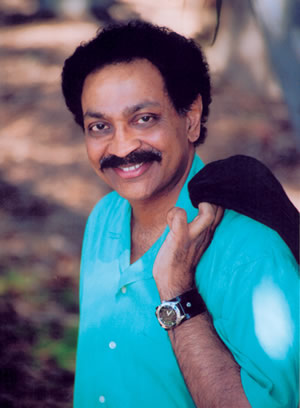UC San Diego's V.S. Ramachandran Named One of TIME 100
Inga Kiderra | April 25, 2011

V.S. Ramachandran
Photo/Beatrice Ring
President Barack Obama, Secretary of State Hillary Clinton, Facebook founder Mark Zuckerberg and UC San Diego researcher V.S. Ramachandran. What do they have in common? They all are on TIME Magazine's 2011 TIME 100 list. The list identifies the most 100 influential people in the world according to the magazine.
Others on this year's list include Chinese dissident artist Ai Weiwei, French President Nicolas Sarkozy, rock legend Patti Smith, TV pioneer Oprah Winfrey and Wael Ghonim, the Google executive credited with helping fire up the recent revolution in Egypt.
"With his simple, creative and innovative ideas," writes Thomas Insel, director of the National Institute of Mental Health, in TIME, "V.S. Ramachandran is changing how our brains think about our minds."
What Ramachandran (often called just "Rama") does, and does proudly – reveling in how "low-tech" his method is and how "Victorian" its inspiration – is to work intensively with patients who have specific psychiatric or behavioral dysfunctions that might illuminate the functions of the normal brain.
Ramachandran hopes that the TIME honor will open up some new research possibilities for him, with people who may have not heard of him before, he said, contacting him as a result of the exposure and volunteering to be studied.
Ramachandran takes as his models 19th-century giants of science Charles Darwin and Michael Faraday. He praises them for wide-ranging and capacious thinking, for being willing to investigate phenomena that others might consider trivial.
"Science has become too professionalized," he said: "It began as grand romantic enterprise" and is now too like an ordinary 9-5 job.
"The history of science and the history of ideas are not taught in universities now, except in philosophy courses," Ramachandran said. "Too much of the Victorian sense of adventure has been lost. I would like to reignite some of that passion in students."
Ramachandran has himself been using his "Victorian" method throughout his career, and it is evident in his books. The first, the acclaimed "Phantoms in the Brain" (1999), coauthored with New York Times science writer Sandra Blakeslee and later turned into a PBS special, detailed his breakthrough work on the phantom limbs of amputees. Ramachandran's "mirror therapy" for phantom limb pain is now being used to treat veterans at the Walter Reed Army Medical Center.
His second book, "A Brief Tour of Human Consciousness," based on the prestigious BBC Reith Lectures he delivered in 2003, considered synesthesia and Capgras delusion, among many other intriguing conditions and phenomena.
His third and latest, "The Tell-Tale Brain," treats all these and more. The reviews are not all unequivocal in their praise, but as usual he has drawn some hard-to-beat superlatives: "This is the best book of its kind that I have come across for scientific rigor, general interest, and clarity" (New York Review of Books) and "I cannot imagine a better account of the sweep of contemporary neuroscience" (Financial Times).
Ramachandran published a paper in Nature as a second-year undergraduate and has since gone on to being dubbed, by Richard Dawkins, the "Marco Polo of neuroscience." That epithet can be found in his Wikipedia entry and in scores of media stories, including the sub-headline of his New Yorker profile ("Brain Games," May 11, 2009). The Royal Institute of Great Britain elected him to an honorary life membership. Newsweek named him to its "Century Club" as one of the 100 most prominent people to watch in the 21st century. And the president of India conferred on him one of the country's top civilian awards and honorific titles: the Padma Bhushan. For Pete's sake, he even has a dinosaur named after him!
The TIME 100 list recognizes activism, innovation and achievement. As TIME Managing Editor Richard Stengel has said in the past, "The TIME 100 is not a list of the most powerful people in the world, it's not a list of the smartest people in the world, it's a list of the most influential people in the world. They're scientists, they're thinkers, they're philosophers, they're leaders, they're icons, they're artists, they're visionaries. People who are using their ideas, their visions, their actions to transform the world and have an effect on a multitude of people."
Ramachandran plans to go to the April 26 gala at the Jazz at Lincoln Center in New York City. A black-tie dinner for 300, the event will feature many current and former members of the TIME 100.
"Obviously, I feel honored to be named to the list," Ramachandran said. "But I'm really looking forward to the party in New York – it'll probably be the most interesting place to be in America at that moment."

|